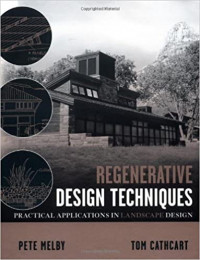
Textbook
Regenerative Design Techniques: Practical Applications in Landscape Design
This resource on the many regenerative technologies contributing to sustainable human life support systems came about through our reliance on a great many experts. The major contributors are listed here. Editor Margaret Cummins talked to us by telephone several times convincing us of the need for a comprehensive resource focused on the technolo gies that contribute to creating sustainable environments. Even though Tom and I had been teaching classes for about five years that were creating sustainable master plans composed of regenerative technologies, this book was her idea. Landscape architect and department head Cameron Man instilled an interest in the early 1980s onthe importancein creating sustainable landscapes. This direction was very insightful. A hero. Dr. Bill Wolverton, was very generous with his knowledge of creating biologically based water and air purification systems. Dr. Charlie Wax, geographer and climatologist, has been a regular contributor to our knowledge of how climate and sun path affect energy flows in the landscape. Accounting professor Dr. Mark Lehman shared his interest in the different ways of accounting for different costs. Dr. John Hargreaves provided a direct link back to the original thinking done by the biologists with the New Alchemists in their quest for creating sustainable environments. Dr.Armondo de la Cruz assisted us with basic biology and ecology issues. Nutritionist Dr. Wanda Dodson served as a mentor on the relationship of food production to human health. Carolyn Adams, USDA Watershed Science Institute Director, provided an opportunity for us to learn about Best Management Practices pertaining to the treatment of runoff from the built landscape. Landscape architect Ernie Dorrill with NRCS provided examples of planning to accommodate water runoff in developing landscapes.
Ketersediaan
| 0000009423 | 712.5 MEL r | Library Pusperkim | Tersedia |
Informasi Detail
- Judul Seri
-
-
- No. Panggil
-
712.5 MEL r
- Penerbit
- Canada : John Wiley & Sons., 2002
- Deskripsi Fisik
-
vi, 410 hal.; ilus.; 19,5 x 24.2 cm.; indeks.
- Bahasa
-
Inggris
- ISBN/ISSN
-
0-471-41472-7
- Klasifikasi
-
712.5
- Tipe Isi
-
text
- Tipe Media
-
-
- Tipe Pembawa
-
-
- Edisi
-
Ed. 1, Cet. 1
- Subjek
- Info Detail Spesifik
-
-
- Pernyataan Tanggungjawab
-
-
Versi lain/terkait
Tidak tersedia versi lain
Lampiran Berkas
Komentar
Anda harus login sebelum memberikan komentar
 Karya Umum
Karya Umum  Filsafat
Filsafat  Agama
Agama  Ilmu-ilmu Sosial
Ilmu-ilmu Sosial  Bahasa
Bahasa  Ilmu-ilmu Murni
Ilmu-ilmu Murni  Ilmu-ilmu Terapan
Ilmu-ilmu Terapan  Kesenian, Hiburan, dan Olahraga
Kesenian, Hiburan, dan Olahraga  Kesusastraan
Kesusastraan  Geografi dan Sejarah
Geografi dan Sejarah